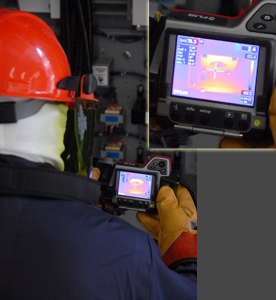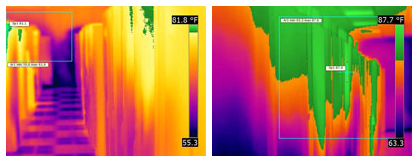I’m sure most, if not all of you, have heard about Amazon Web Services recent outages at their data centers – could any of these outages been helped by data center thermal imaging? The power, cooling and support systems are vital to the continuous flow of information in data centers and telecom facilities. If you had the ability to identify and resolve heat-related issues in your mission critical environment would you do it? Performing data center infrared  thermography or thermal imaging predictive maintenance on your critical support infrastructure is a must and should be seriously considered in your regular data center maintenance schedule.
thermography or thermal imaging predictive maintenance on your critical support infrastructure is a must and should be seriously considered in your regular data center maintenance schedule.
What is data center thermal imaging?
Data Center thermal imaging or infrared thermography is used to “see” the radiation given off by objects. While the infrared radiation is not within the visible light spectrum and therefore cannot be seen with the naked eye, objects still radiate, even in the dark. The hotter an object is, the more it radiates, allowing infrared imaging to differentiate between different objects and locate hot spots.
Infrared thermography in the data center
The electrical switchgear, UPS (uninterruptible power supply), generator ATS (automatic transfer switches), control panels and breakers as well as server systems and cooling systems must be checked with infrared thermography to detect irregularities that cannot be seen with the naked eye. Detecting irregularities in your data center’s critical support infrastructure in the early stages ensures prompt corrective action before costly system failures can occur.
With predictive maintenance comes early detection allowing you to prevent equipment failure and unplanned shutdowns that can be damaging to your company. Regular data center thermal imaging has many benefits such as:
- Identify and correct hidden problems before they become unplanned outages
- Reduce risk of undetected degradation of components due to overloaded circuits or loose connections
- Cost Savings obtained by preventing equipment failures and down time
Regularly performing infrared thermography enables you to put together a detailed history of your equipment and helps to insure the resiliency of your critical facility infrastructure.
Identifying cooling issues with thermal imaging

Infrared scans of data center server racks.
- Image on left shows recirculation of hot air over top of rack, clearly see the lower sections that are closer to perforated tiles are cooler.
- Image on right shows lack of blanking panels allowing hot air to recirculate to front of rack
Does your data center suffer from hot spots due to improper cooling? In addition to identifying anomalies in electrical equipment, data center infrared thermography can also help identify mechanical issues such as hot spots. A thorough analysis can indicate areas that might compromise data center network reliability caused by high-heat. This will enable you to create solutions that will help you to solve the problem as well as helping to reduce operating costs.
Temperature plays an important role in maintaining a stable and efficient data center. Ensuring that server racks and network equipment are kept within safe operating temperatures is key to sustaining the life span and functionality of your critical equipment.
Don’t wait until your data center experiences an outage and costing your company way too much money and possibly customers as well. Add data center thermal imaging to your regular data center maintenance schedule.


